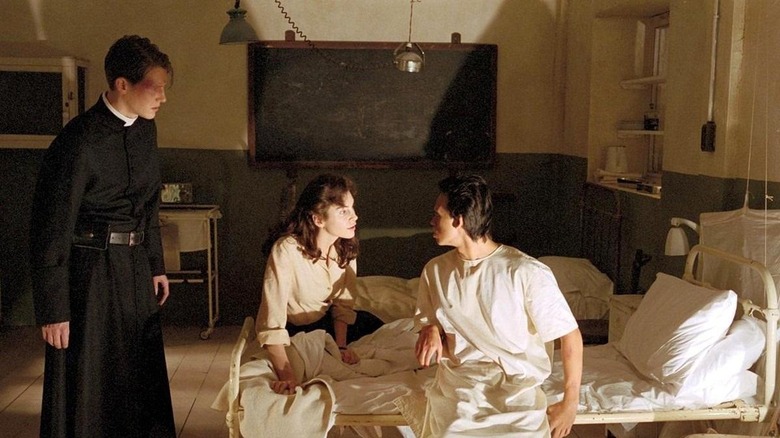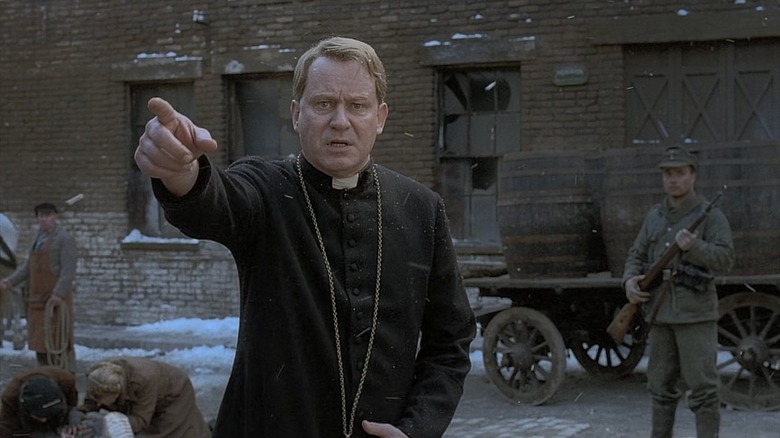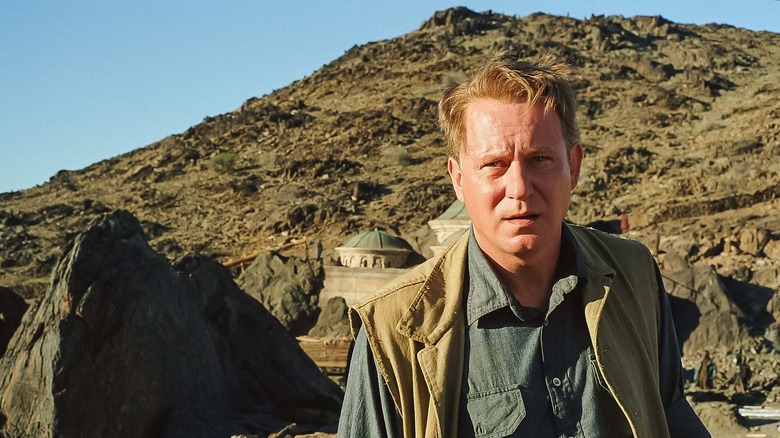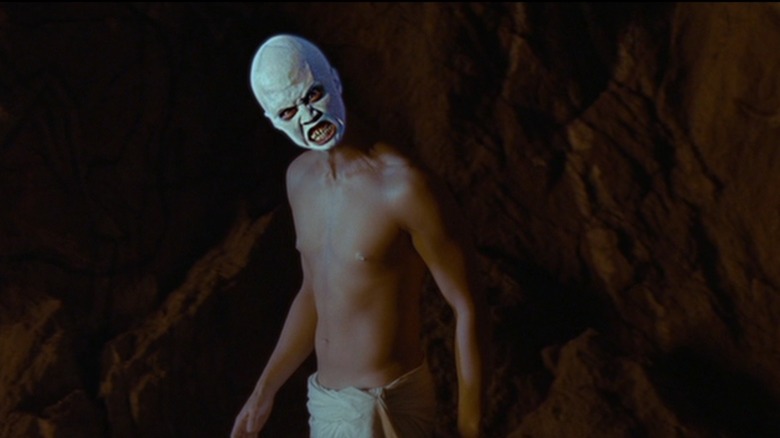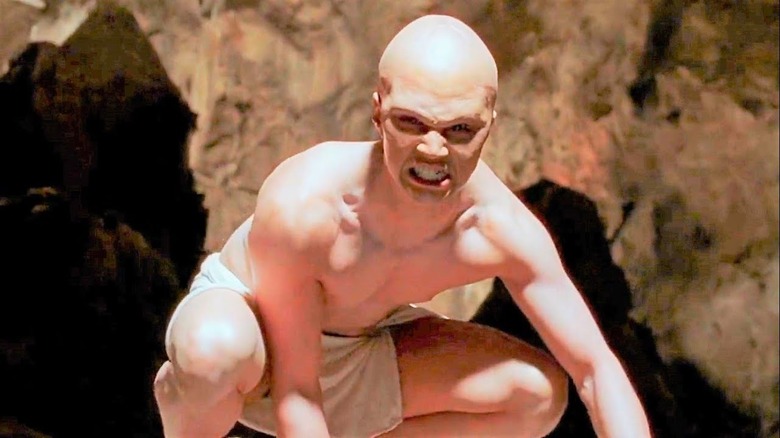Dominion: Prequel To The Exorcist Ending Explained: A Chance To Turn Back Time
I can think of a few living filmmakers better suited to making an "Exorcist" movie than Paul Schrader. From the existential rage and self-loathing of Travis Bickle in "Taxi Driver," through the spiritual torment of Jesus in "The Last Temptation of Christ," to the doubting pastors of "Affliction" and "First Reformed," Schrader has spent much of his career exploring matters of the soul. As Roger Ebert once noted, "One thing [Schrader's] movies have in common is a very strong, visible sense of sin."
So who better to direct an "Exorcist" prequel after William Peter Blatty's flawed "The Exorcist III" marked a return to form for the series after the loopy metaphysics of John Boorman's "Exorcist II: The Heretic?" Surely if anyone could get to the bottom of Father Merrin's past exploits, it would be Schrader, right?
Problems arose because Schrader was only Morgan Creek's third pick to direct the movie. Tom McLoughlin, the man who brought us "Friday the 13th Part VI: Jason Lives," and veteran John Frankenheimer both pulled out before producer James G. Robinson reached for his number. When shooting wrapped, the final result was a bit too Schrader-y for Robinson's liking (via The New York Times).
Schrader was fired and Renny Harlin was brought in to punch things up a little. He ordered another rewrite, cast new actors, and reshot the whole movie. The Devil himself didn't seem to approve — see the "Exorcist Curse" — as Harlin was hit by a car, breaking his leg.
Harlin's "Exorcist: The Beginning" was a disaster, prompting Morgan Creek to meekly release Schrader's original version on a limited run. It didn't fare much better with audiences or critics, but it's fascinating to see two versions of the same film side by side. Let's see how they compare.
So what happens in Dominion again?
"Dominion: Prequel to the Exorcist" opens in the Netherlands in 1944. A German soldier is killed and an SS officer demands that the perpetrator is handed over. Father Merrin (Stellan Skarsgård) vouches for the innocence of his flock, prompting the SS man to execute 10 villagers as a message to the real murderer. He makes Merrin pick the victims.
The incident destroys Merrin's faith, and three years later, we find him working on an archaeological dig in British East Africa. A 5th-century Byzantine church has been unearthed, constructed before Christianity reached those parts. Father Francis (Gabriel Mann) is sent by the Vatican to make sure that the find isn't desecrated.
While workers from the local Turkana community try to gain access to the church, Merrin spots Cheche (Billy Crawford), a disabled young man who has been cast out because the locals think he is cursed. Merrin takes the lad for treatment to Dr. Rachel Lesno (Clara Bellar), who also suffered at the hands of the Nazis during the war.
Once they get inside the church, Merrin and Francis notice that the statues hold their weapons pointed downwards, suggesting it was built to hold down something bad rather than exalt God. They discover a passageway leading to a cavern with a demon statue a little like the Pazuzu one from "The Exorcist." At the hospital, Cheche grows fearful at the exact moment they gain access to the hidden chamber, which Merrin believes was used for human sacrifices.
Disturbing things start happening. A herd of cows kills the hyenas that stalk the dig and graze on their carcasses, and the chief's wife delivers a stillborn baby crawling with maggots. Village elders warn Merrin to stop digging as they fear the church is the source of evil.
History threatens to repeat itself
Father Francis wants to notify the Cardinal about the find and bring in British troops to secure the site, but Merrin worries that the church will be looted if word gets out. Despite his protests, Major Granville (Julian Wadham) sends for reinforcements. Merrin's fears prove warranted as two soldiers enter the church to loot precious stones from the altarpiece.
The men are found horribly butchered the next day — one decapitated and the other crucified upside down. A Turkana warrior claims that he saw them turn on each other. Merrin argues that the symbolism of the poses is Christian, not pagan. This doesn't wash with Granville, who has grown uncharacteristically aggressive towards the locals. Echoing the opening scene in the Netherlands, he shoots a young woman on the spot in retribution for the deaths of his men.
Things escalate as the warrior bursts into the local school and murders the children to stop the "Christian evil" from spreading. Meanwhile, Cheche has undergone surgery on his lame leg, which heals remarkably quickly. His withered arm, which Rachel believed was unrecoverable, also grows strong. Unknown to everyone, he is displaying the characteristics of being possessed. When he awakes from the anesthetic, he says he would like to become a Christian, but only wants to do it in the church.
Alarm bells should be ringing, but Father Francis is all for a baptism to save the young man's soul. The enraged community wants the boy handed over so they can kill him, correctly believing he is possessed. The baptism goes predictably awry as the demon inside Cheche attacks the priest. Realizing an exorcism would be more appropriate, Francis dashes off to find his copy of the Roman Ritual, leaving Rachel alone with her patient.
The exorcism
Father Francis is discovered riddled with arrows like Saint Sebastian, continuing the theme of the victims' bodies being arranged in Christian poses. He still has enough life in him to tell Merrin that Cheche is possessed and needs an urgent exorcism.
Merrin goes to the church and finds Rachel under the influence of the demon. She tells him that the fiend offered her the chance to rewrite her past. Merrin briefly confronts the demon, who tells him that Rachel betrayed her friends in the concentration camp. Is it true, or is the Devil up to his old tricks?
He then returns to town and prays to God. In a scene that plays a little like "John Wick" digging up his guns, Merrin busts out some priestly vestments and heads to the church to perform the rite. The demon also offers him an opportunity to change history and clear his crushing guilt. In a vision, Merrin disarms the SS officer and shoots him, prompting the German soldiers to open fire and kill everyone anyway, including the priest. The demon mocks Merrin's guilt and encourages him to "cease to care."
Meanwhile, it's all kicking off back in the town. A spooky aurora, looking like a special effect from "Exorcist II: The Heretic," shimmers in the sky as Rachel prepares to cut her own throat and the Turkana warriors attack the British soldiers.
Thankfully, Merrin recovers his faith just in time and exorcizes the demon, averting multiple deaths and turning Cheche back to his former disabled state. A Turkana elder warns Merrin that he has made an enemy of the demon, nicely setting the table for "The Exorcist." Merrin says a tender goodbye to Rachel and walks away into the sands, ready to become a priest again.
How does Dominion compare to Exorcist: The Beginning?
After sitting through Renny Harlin's amped-up rehash, Paul Schrader's original "Exorcist" prequel is a fascinating watch. Both versions broadly hit the same beats, but Schrader's film is a far more somber examination of the evil that lurks in mankind. Without all the gaudy bells and whistles Harlin added, it's a pretty stripped-back affair. There is no flashy back story for the church or hyena attack on little kids; no Alan Ford gnashing his teeth like gangster Bricktop in "Snatch;" no Vatican cover-up for Merrin to unravel or a twist ending; and no unnecessary gore and jump scares. What they do share is some very bad CGI.
There are also no callbacks to the original trilogy. Harlin switched out the demon statue for one that looks exactly like the one in "The Exorcist" and had the plot re-jigged to include the St. Joseph medallion and the Pazuzu statuette head, two important symbols of good and evil in William Friedkin's 1973 film. Those changes felt more like fan service than actually adding much to the story.
Without the title and the name "Merrin," you might not necessarily know Schrader's film was part of the "Exorcist" franchise. Indeed, it is almost as if he had little interest in actually making a horror movie. This is fine because the most interesting scenes in "The Exorcist" are the quiet ones exploring faith, while the head-spinning and pea-soup vomiting feel more like sideshow attractions these days.
Schrader's earnest approach allows the actors to explore their characters in greater detail. Father Francis is a far more sympathetic presence than the 'Father Exposition' he becomes in Harlin's version. Julian Wadham, a survivor of both movies, makes Major Granville a believable study of a man losing his morals and his mind, without the hokey butterfly death scene in the reshoot.
What difference did the changes make to the ending?
The storyline of both "Exorcist: The Beginning" and "Dominion: Prequel to the Exorcist" are roughly the same: demonic evil lurking beneath a mysterious church in East Africa begins to turn people against one another, and Father Merrin must recover his faith to thwart it. Most of Renny Harlin's distracting add-ons don't steer the film too far from that narrative, but there are two major changes that significantly alter the emphasis of the ending.
Paul Schrader's film treats Merrin's traumatic experience during the war with greater respect. Rather than dishing it out in small chunks as part of a gradual reveal as Harlin does, the incident that broke the priest's faith opens the film in full. This lets the theme of historic evil repeating itself play out organically as tension rises between the British and the Turkana, and also makes the final confrontation between Merrin and the demon more satisfying.
Secondly, Harlin's film switched the possessed person from Cheche (who doesn't appear in the reshot version) to the doctor, renamed Sarah (with former Bond girl Izabella Scorupco recast in the role). Presumably, this was to give the film extra glamor and provide Merrin with a more overt love interest. Harlin also uses her for the twist ending, faking us out by first presenting a young boy from the village as the possessee.
Both these elements feed into the climactic exorcism. Harlin also strips out the key scene of the demon tempting Merrin with a chance to make amends, turning the rite into a straightforward situation where he must beat the bad guy and save the girl. Harlin's ending feels very generic, without any of the philosophical questions that make Schrader's version a solid addition to the "Exorcist" series.
What does the ending of Dominion mean?
The demon's offer to help Merrin change the past presents some interesting food for thought. Even assuming that the alternative timeline the demon shows him is true, would the knowledge that his actions made no difference to the overall outcome absolve him of guilt? Guilt is part of the Catholic faith, but there are two kinds. Healthy guilt helps people take stock of their lives and make positive changes, while unhealthy guilt leaves them dwelling on events that they cannot change or control.
While the vision he's shown might seem like a bit of a pep talk to help Merrin realize he is wallowing in unhealthy guilt, there is a more devious motive. The demon wants to drive a further wedge between him and God, possibly severing ties forever. If the ploy succeeds, Merrin will no longer present any threat to the Devil's plans.
But Merrin has the resolve to reject the demon's lies and continue with the exorcism — in the process, he makes an enemy for life. Perhaps that is why elderly Father Merrin (Max von Sydow) is visibly shaken when the Pazuzu statuette head is unearthed at the beginning of the original "The Exorcist." He knows that another confrontation is imminent and he may not survive it this time.
At its core, "Dominion" is similar to "The Exorcist," focusing on a priest suffering a crisis of faith who delivers an innocent from the clutches of the Devil. One of the main differences, as Schrader has pointed out (via Captain Howdy), is that it focuses on an afflicted boy "glorified" rather than a normal girl tormented. And the priest gets to survive this one, setting up the epic confrontation in "The Exorcist."


